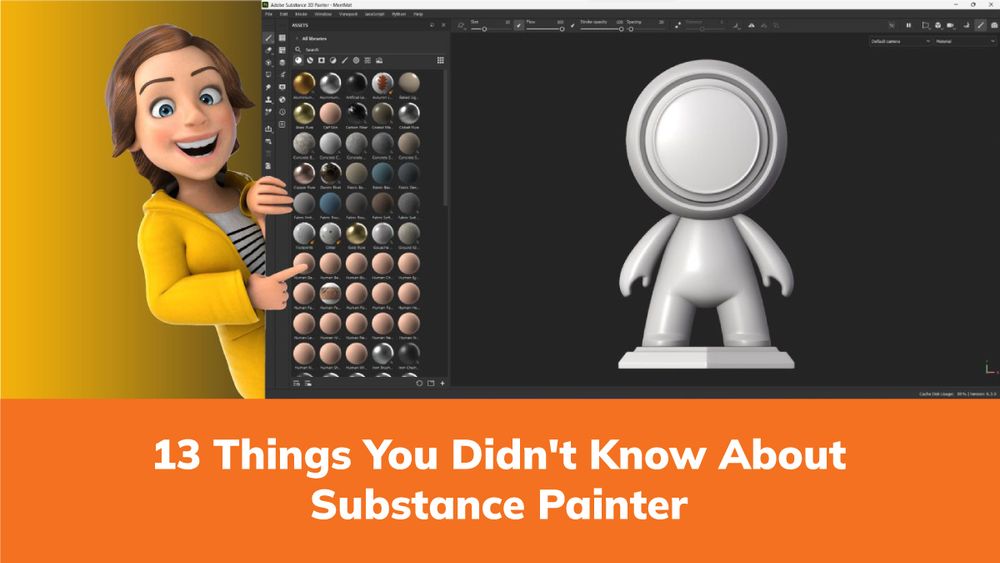13 Things You Didn't Know About Substance Painter
Substance painter is a game changer. It is a popular 3D texturing software artist and game developers use to create high-quality textures and materials for their models. Whether you're a beginner or a seasoned professional, there are a few key things to remember when working with Substance Painter. In this blog post, we'll explore five important things about Substance Painter that can help you create stunning, photorealistic textures.
9 Reasons for You to Get Started with Substance Painter
The benefits you will get as you learn substance painting online are extensive. Check out the top 9 reasons listed here to get started with substance painting.
- You will become a texturing expert.
- You can learn the magic that is proceduralism.
- It has a familiar photoshop interface.
- The edge wear and the surface imperfections are made even easier.
- Baking tools are used for transferring high-poly detail to your normal maps.
- You will learn substance painting online quickly with the help of texturing with substance painter tutorials.
- You can quickly add logos to your models.
- You can build in the filters for fast physical effects.
Also Read: A Quick Guide to Start Your Journey with Substance Painter
5 Important Things to Know about Substance Painters to Create Stunning Textures
9: PBR Workflow
The physically based rendering (PBR) methodology used by Substance Painter allows for creating textures that faithfully mimic how light interacts with various materials in the real world. This can facilitate the creation of more realistic and uniform textures and make it simpler to produce a consistent appearance across various models.
Albedo, roughness, and metallic are the three guiding concepts of Substance Painter's PBR approach. While the roughness texture determines how reflecting or matte the material appears, the albedo texture establishes the substance's base colour. How much the substance reflects light like a metal depends on its metallic texture.
For Substance Painter to produce convincing and realistic materials, it is imperative to comprehend how these three textures interact. In addition, Substance Painter offers additional maps, like height, emissive, normal, and more, which can enhance the complexity and level of detail in your textures.
10: Layer-Based Workflow
You may create textures by stacking various layers on top of one another in Substance Painter's layer-based workflow. This method gives you much control over your textures and is a lot like using layers in Photoshop or other image editing applications.
With Substance Painter, each layer can have a variety of textures applied to it, such as albedo, roughness, or metallic. These textures can be altered or combined with other layers to achieve the desired look. Furthermore, Substance Painter supports using masks, which may be applied to your model to apply textures to particular regions selectively.
The layer-based workflow in Substance Painter makes it easy to experiment and iterate on your textures, allowing you to make changes and adjustments as needed quickly.
11: Real-Time Preview
The real-time preview mechanism in Substance Painter is one of its greatest benefits. You can instantly iterate and perfect your materials since you can see the changes you make to your 3D model as you paint and modify your textures.
A physically based rendering engine, which faithfully models how light interacts with various materials, powers Substance Painter's real-time preview system. This makes building textures that look excellent in any environment simpler because you can see how they will appear in various lighting situations.
12: Smart Materials and Smart Masks
Various built-in smart materials and smart masks in Substance Painter can speed up your workflow and produce more intricate and realistic textures. Smart materials are pre-built textures with various layers and modifications intended to mimic a particular kind of material, like rust or leather. You can add these materials to your model with just one click and alter and modify them as necessary.
On the other hand, smart masks let you carefully apply textures to particular portions of your model. They work similarly to layer masks in Photoshop and let you make intricate textures without manually painting them.
13: Integration with Other Software
Finally, Substance Painter is easy to integrate into your current workflow because it works flawlessly with other 3D modelling and game development programmes. FBX, OBJ, and Collada are just a few file types that Substance Painter supports, making it simple to import and export models from other programmes. Moreover, Substance Designer, an Algorithmic programme that enables you to design unique materials and textures and import them into Substance Painter, may be connected with other Algorithmic programmes.
In conclusion, Substance Painter is a formidable 3D texturing programme that provides a variety of capabilities that can assist artists in swiftly and simply producing high-quality textures. The ability to employ particle brushes, develop procedural materials and smart materials, and interact with other programmes are a few of learn Substance Painter online and its lesser-known features. Using these tools, artists may easily produce gorgeous 3D models and advance their texturing skills. Regardless of your level of artistic experience, Substance Painter is a tool worth investigating to enhance your 3D texturing workflow.

